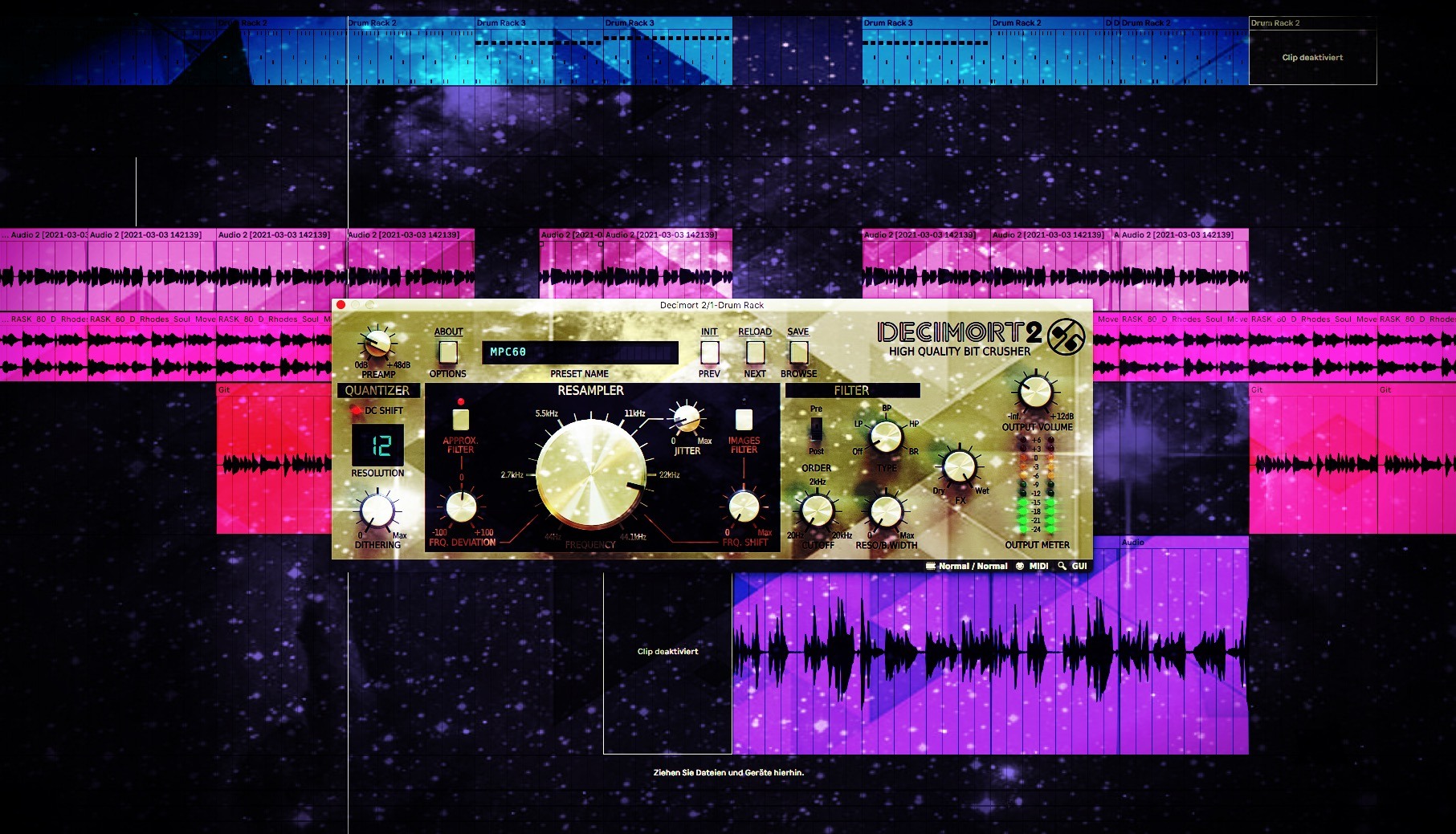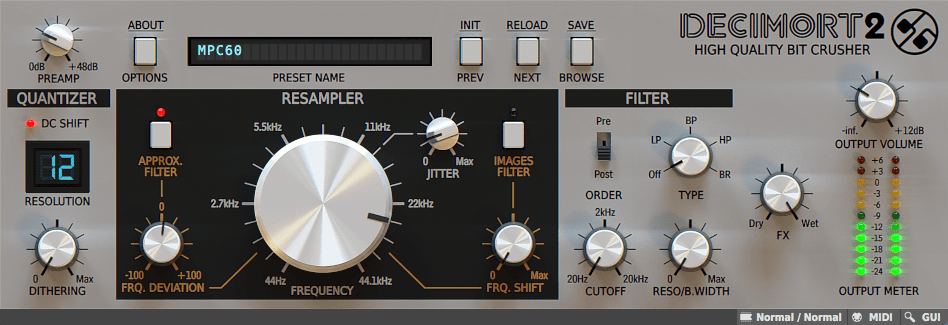Bitcrushers … I have to admit that I’ve never been a huge fan of bit crushers. Except for 1980s video game sounds or astronaut voices I couldn’t find any use for them in my music. Until I found out about D16 Group Decimort 2 and how it can fatten drums by making them sound like they’ve been sampled through a good old MPC60 or another vintage sampler.
The D16 Decimort is an often overlooked secret weapon for that old school hip hop sound. One of my all time favorite plugins – oops! I’m getting ahead of myself here:-) So without further ado, let’s jump into the D16 Decimort 2 Review.
| This post contains affiliate links. If you make a purchase through these links, we may earn a commission at no extra cost to you. It’s a simple way you can support our mission to bring you quality content. |
First Look
In essence the D16 Decimort 2 is a bit crusher and sample rate reducer – in short a digital degrader. But unlike most digital degrading plugins it doesn’t just reduce the bit depth and sample rate, which inevitable leads to artifacts such as a harsh ringing and modulating noise.
I won’t go into too much technical detail here. If you have ever used bitcrushers, you know how these artifacts sound. In some cases these artifacts are exactly what we want, but what if you would just want to have the grit and punch of a vintage sampler?
There’s a bit more to it than just reducing the resolution of digital audio. All kinds of filtering and the addition of noise masking some artifacts are vital aspects to the sound of all higher quality digital audio devices.
And this is where the Decimort 2 comes in, as it replicates all the relevant stages used in vintage samplers.
These stages are from left to right on the plugin surface: preamp, quantizer, resampler, filter, dry/wet control and output volume. Let’s examine these stages one by one.
The Preamp
To the upper left there’s the preamp, which determines how hot the signal goes into the digital degrading sections, which has a profound effect on the sound.
The Quantizer (a.k.a Bit Crusher)
After the preamp, comes the quantizer, which reduces the bit depth. It can go from 16 down to 1 bit. The DC shift determines how the digital signal crosses the zero. If you want to know what that means technically, please read the plugins user manual. The point relevant to us producers is, that it changes the sound. I like the DC shift on, as it gives the sound a little more punch.
The dithering knob controls the amount of noise that gets added to the reduced signal. In short, dither noise masks artifacts that occur with low bit depth. Soundwise that means, that the audio has a constant noise floor instead of modulating noise.
The Resampler
At the center of the user interface there is a nice big knob for the sample rate reduction, which puts the sample rate reduction at the heart of the D16 Decimort 2. At the same time it is the most complex section.
The Resampler has two filters, one before and one after the sample rate reduction. Both filter out overtones. The Approximate Filter, which comes before the sample rate reduction, filters out overtones created by the bit reduction. The Images Filter, which is located behind the sample rate reduction, removes overtones created by the latter.
And then there is the jitter control. In case, you don’t know what jitter is: Roughly speaking, jitter is the inaccuracy of the clock. When the sample rate is e.g. 44.1kHz, the audio signal is divided into 44.100 “slices” per second. In an ideal world these slices would all have the exact same duration. But in reality that’s not the case and the lower quality a digital audio device, the more the slices vary. This variation is called jitter.
Again, the interesting part for us producers is, that jitter has an effect on the sound and the Decimort 2 plugin gives us control over how much jitter we induce into our sounds.
The Analog Style Filter
After the sample rate reduction comes the filter section, a classic analog style filter with low pass, high pass, band pass and band reject modes and controls for the cutoff frequency and the resonance.
For more flexibility the filter section can also be placed before the bit reduction, via a pre/post switch.
Last but not least come the dry/wet control and the output volume.
The Decimort 2 Plugin In Use
Decimort 2 comes with 115 well-chosen presets, organized in different categories, so you can quickly find a sound or starting point for further manipulation. I personally use the plugin mainly for the vintage sampler emulations. In that case its as simple as choosing a preset, fine-tuning the preamp level and forgetting about the rest.
However, its worth playing around with all the settings. As technical as the controls are named, its easy to get a grip of how the different controls affect the sound, once you start messing with them. The layout is clear, and I like its look emulating old studio and hifi devices.
I just wished the buttons for the preset management would be a bit bigger – I find them real tiny – and that they would not have a double function. E.g. Browse and Save share the same button. You’ll have to hold the Command key (Mac) / Ctrl Key (PC) while clicking the button to save a preset. This is just a minor issue but it also doesn’t make sense to me.
Other than that, the preset management is clear and fast to navigate.

Unfortunately the preamp knob cannot be linked to the output level. A linking of the two would help to focus on the sonic change of pushing the preamp rather than being fooled by the “louder sounds better” phenomenon. This one of those features that is still not standard and that I miss in a lot of plugins.
PLUGIN DEVELEPORS, IF YOU READ THIS: PLEASE GIVE US LINKING OF INPUT AND OUTPUT LEVELS OR AUTOMATIC GAIN COMPENSATION IN YOUR PLUGINS. IT MAKES OUR LIVES AS PRODUCERS A LOT EASIER!
By the way, even free plugins like the TDR Slick EQ have that feature;-)
How Does the Decimort 2 Sound?
Let’s get to the most important aspect, the sound of the D16 Decimort 2 plugin. Is it capable of bringing the punch and grit of vintage samplers like the MPC60, SP1200 or ASX10?
Before I share my personal judgment, a short disclaimer: As I have never owned a vintage sampler nor worked with one, I can’t tell if the emulations are accurate or not.
Having said that, we all know the iconic sound of 80s and 90s Hip Hop by the likes of Public Enemy, De La Soul, BDP, Gang Starr etc. And I find that the Decimort 2 does a beautiful job of adding that typical old school Hip Hop grit and punch, especially to drums. To me that is the main seller and the reason why I own the Decimort 2 and use it in almost every production.
The ability to do crazy stuff with the Decimort 2 is just a bonus to me, but it may be the main benefit for you. In any case its good to have. And yes, you can go crazy with bit depth as low as one bit and a sample rates as low as to 44 Hz (not kHz)! The analogue style filter is also a welcome addition, not only to shape the digitally degraded sounds. It also does a great job as a standalone filter.
Conclusion
The D16 Decimort 2 plugin is by far my favorite bit crusher and resampler on the market. What separates it from other plugins of that kind, is its ability to authentically reproduce the sound of vintage samplers such as the MPC60, the SP1200, ASX10, S20 etc.
There is more than just reducing the bit and sample rate that made these machines spit out these crunchy sampled drums, that defined the iconic sound of Hip Hop – and related genres – in the 80s and 90s. Decimort 2 respects that fact and includes all the relevant processing stages to achieve that sound.
Beyond the reproduction of the sound of vintage samplers, Decimort 2 is a bit crusher on steroids, with a ton more ways to manipulate a sound than any ordinary bit crusher. With a preamp section, three filters, DC shift and jitter control, it blows other bit crushers out the water.
If you are into 1980s video game sounds, walkie-talkie voices or if you are a LoFi or Boom Bap producer on the lookout for that punchy vintage sampler sound, you should definitively try out the D16 Decimort 2 plugin.
Do you have any questions about the D16 Decimort II? Which is your favourite vintage sampler plugin? Please leave your comments below!
| PROS | CONS |
| Authentic Vintage Sampler Emulation More Versatile Than Most Bit Crushers Clear User Interface Good Presets | No Linking Of Input And Output Gain |

